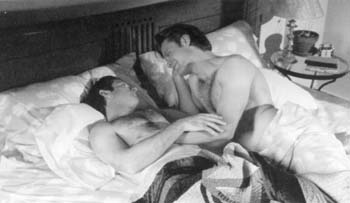![[Metroactive Movies]](/movies/gifs/movies468.gif)
[ Movies Index | Show Times | San Jose | Metroactive Central | Archives ]
 Sleep-Over: Matt Keesler (right) and Dan Futterman get cozy in 'Urbania.' Night Tales A man searches through layers of legends in 'Urbania' 'THERE ARE eight million stories in the Naked City," intoned the narrator of the since-forgotten TV show of that name. Performance artist Laurie Anderson added, "And the only problem is that no one can remember which one is theirs." In a state of hallucinatory near-amnesia, Charlie (Dan Futterman), the hero of Urbania, wanders the Manhattan streets at night. The only stories he can clearly remember aren't his own--they're the stories of fatal personal risk summed up in urban legends. He recalls the stolen kidney, the microwaved poodle, the infected needle in the coin return slot of the pay phone. Retelling these spurious tales, Charlie wanders the streets and bars of New York at night, looking for a specific man. Charlie's fascination with a tattooed thug (Samuel Ball, a sort of living Tom of Finland drawing), turns out to be more than just infatuation. The story of a wandering man can't help but be episodic. At first, Urbania seems worth congratulating because you can't tell where it's headed. Then, about an hour in, it seems as if it will never arrive. That Charlie's journey is wrapped up by a plausible horror story leaves a thrilling impression even if the episodes are uneven. A sequence in which Charlie visits Brett (Alan Cumming), a former lover, goes on too long. Brett has AIDS and is trying to keep up a good front; in movies "the good front" is just a way of choking up the audience. Cummings plays it wistfully, showing a mawkish streak that could be a real trouble for him in future movies. Also, there's an incident where Charlie tells off a happy, simpleminded and homophobic straight couple. In this scene, actor Megan Dodds is such a stereotypical, girly, blonde cookiepuss that she's even named "Deedee." I'm sure the scene is a crowd-pleaser for gay audiences, and there's a certain justice to it, but it's unbelievable. Worse, unlike the rest of the film, you can see exactly where it's headed. First-time director Jon Shear uses fast editing to heighten the sense of tension. The photography is Super16 transferred to digital. The effect's worth recommending. The short depth of field and high contrast in 16mm are perfect for a sinister, low-budget tale--the people in the distance look like white-faced ghouls, as if this were Carnival of Souls all over again. The pixels soften the usual grain of 16mm, making the surfaces velvety and yet vivid. The cityscapes of New York at night look hot and tantalizing. Though the OED doesn't confirm it, I could swear from my brushes with Victorian porn that "Uranians" used to be a slang term for homosexuals. The word's got nothing to do with urine: it means the heavenly ones, and, I believe, the hidden ones too. Even if the title is just a way of suggesting that New York at night is the imaginary kingdom of Urbania, the urbane title is an improvement on the title of the source material, Daniel Reitz's play Urban Folk Tales. And this mystery has details for the viewer to discover--such as how the crescent-shaped scar on Charlie's chest matches the story of the stolen kidney. (As we learn in the finale, Charlie has, essentially, had his heart cut out and taken.) Futterman is best known as the sly redheaded rogue in the movie Shooting Fish. He's fascinating as a New Yorker on the edge, and it's impossible to tell here, until the end, whether the madness of his Charlie is dangerous or not. In a cinema that too often lays everything on the line, Urbania stays intriguing right up to the finish.
Urbania (R; 103 min.), directed by Jon Shear, written by Shear and Daniel Reitz, photographed by Shane F. Kelly and starring Alan Cumming and Dan Futterman, opens Friday at the Towne in San Jose and the Aquarius in Palo Alto. [ San Jose | Metroactive Central | Archives ]
|
From the September 14-20, 2000 issue of Metro, Silicon Valley's Weekly Newspaper.
Copyright © 2000 Metro Publishing Inc. Metroactive is affiliated with the Boulevards Network.
For more information about the San Jose/Silicon Valley area, visit sanjose.com.